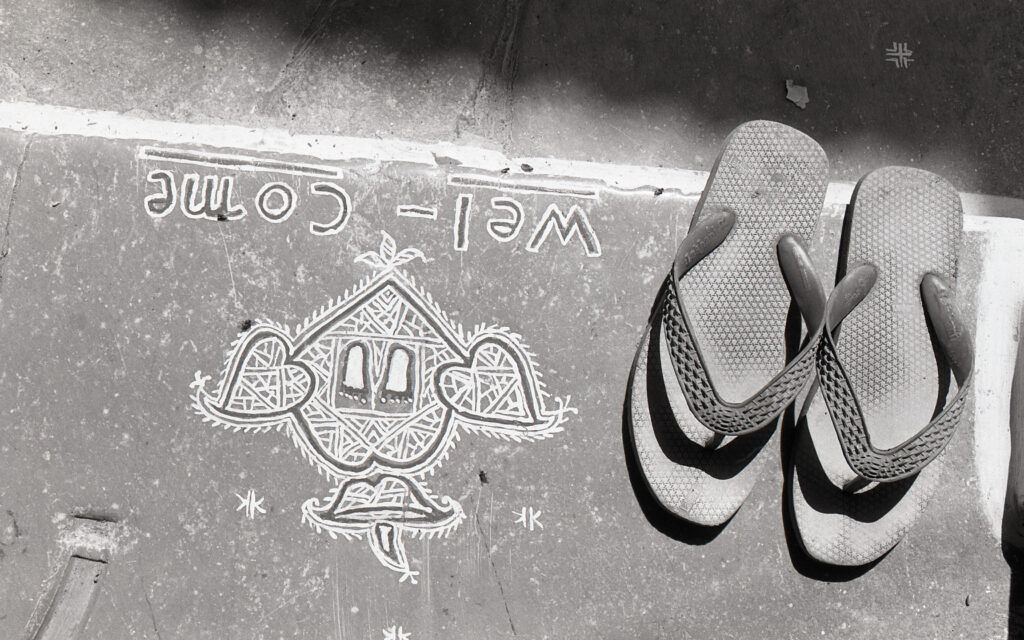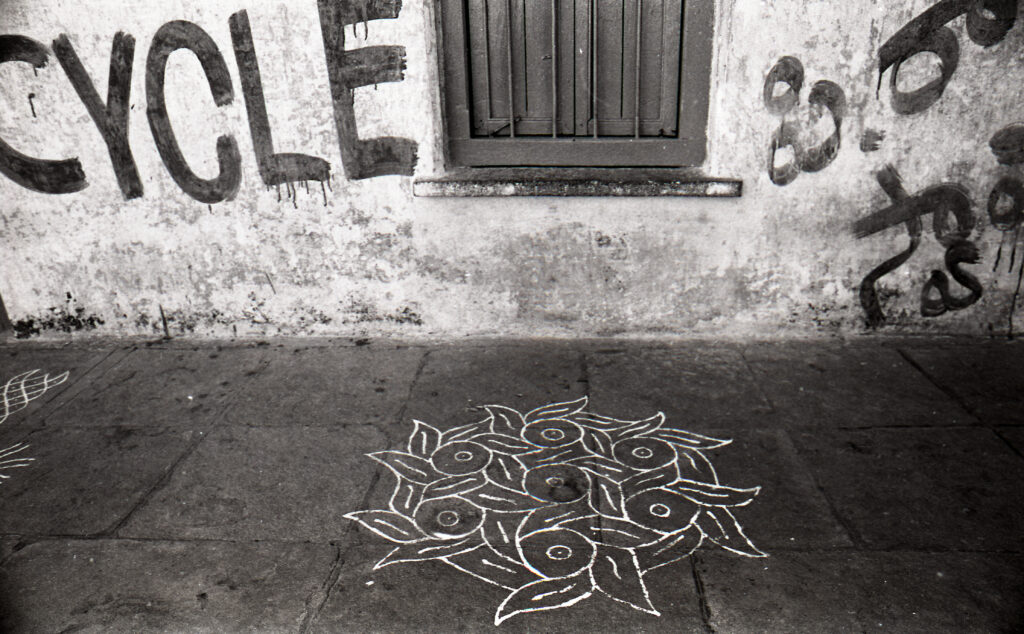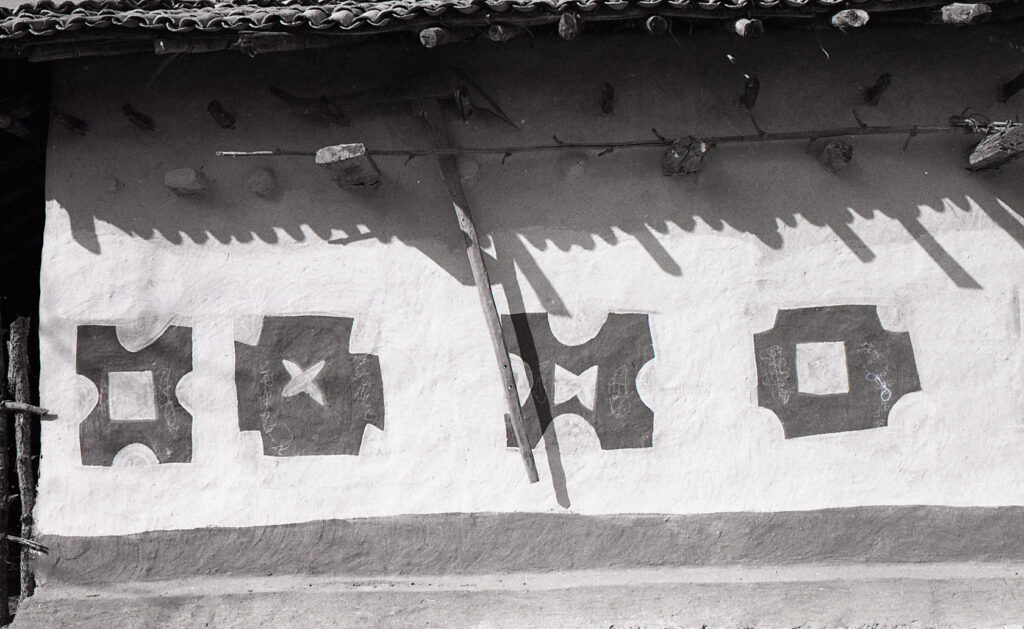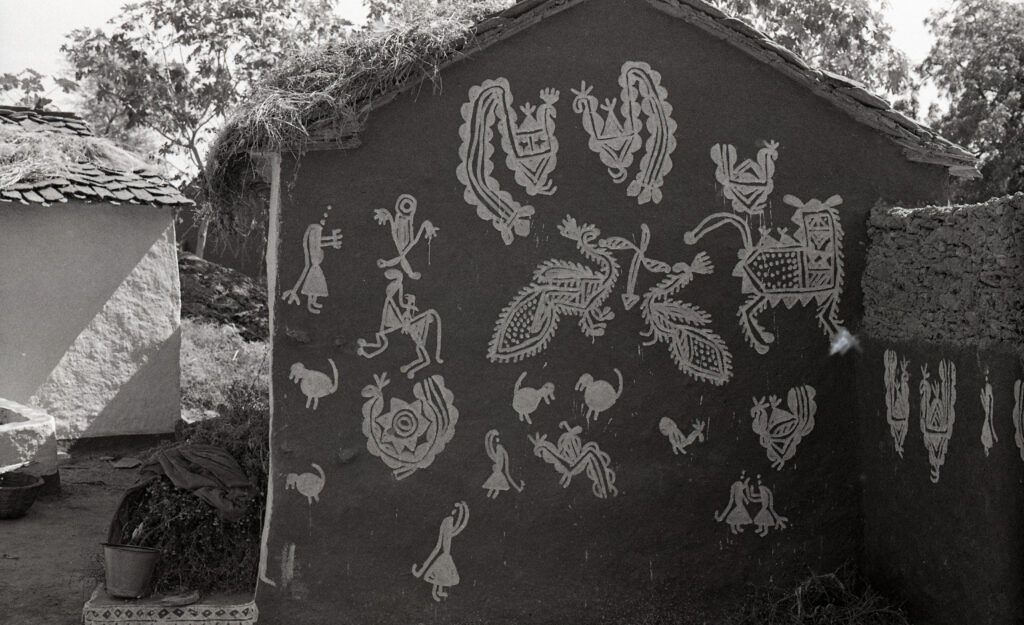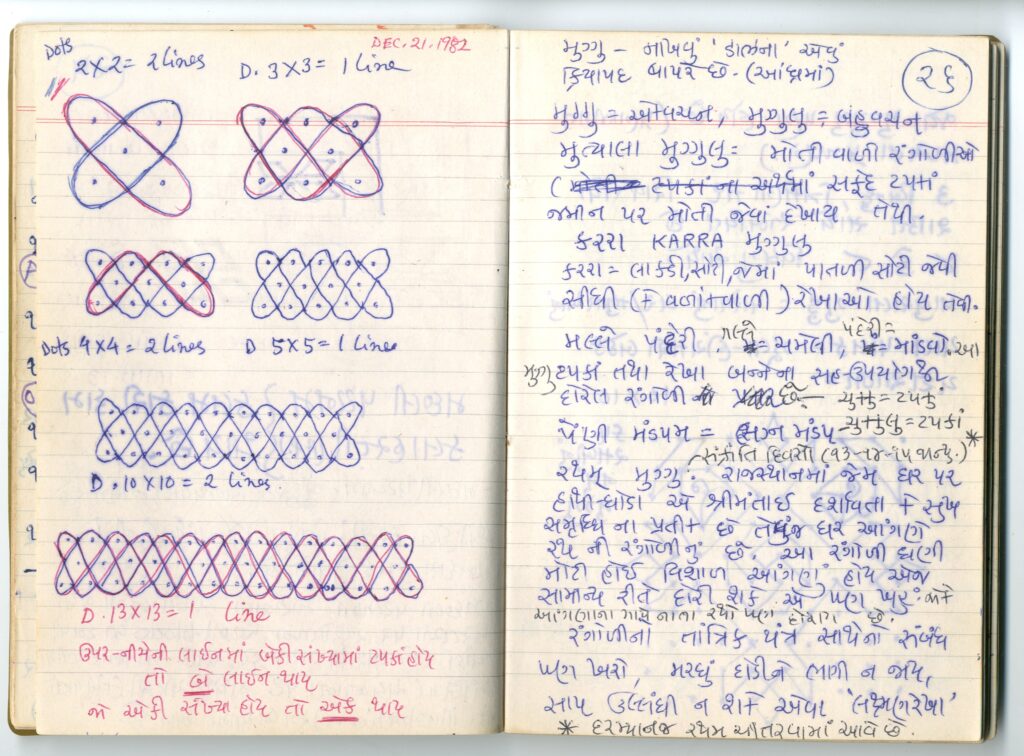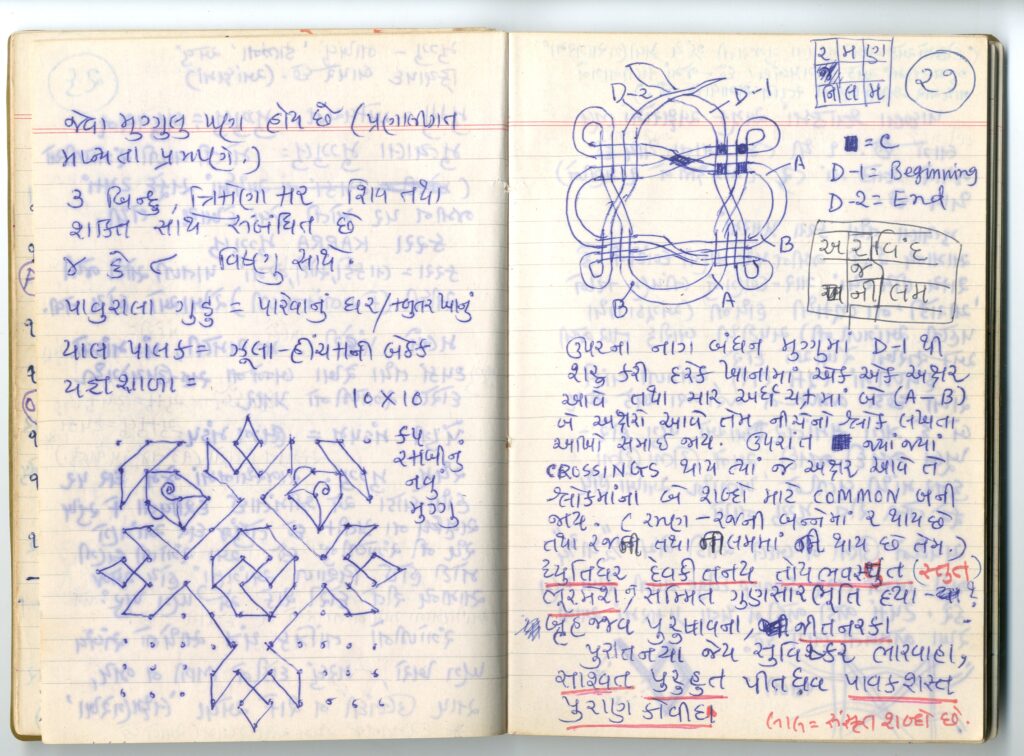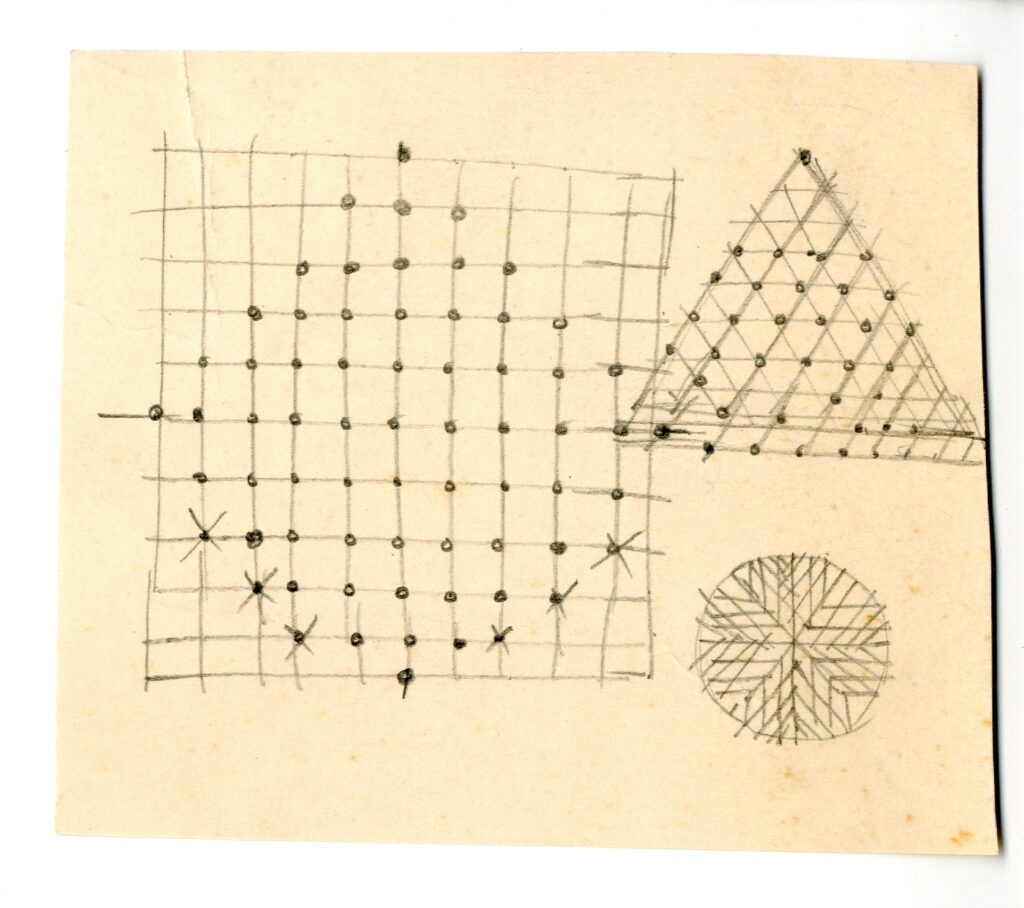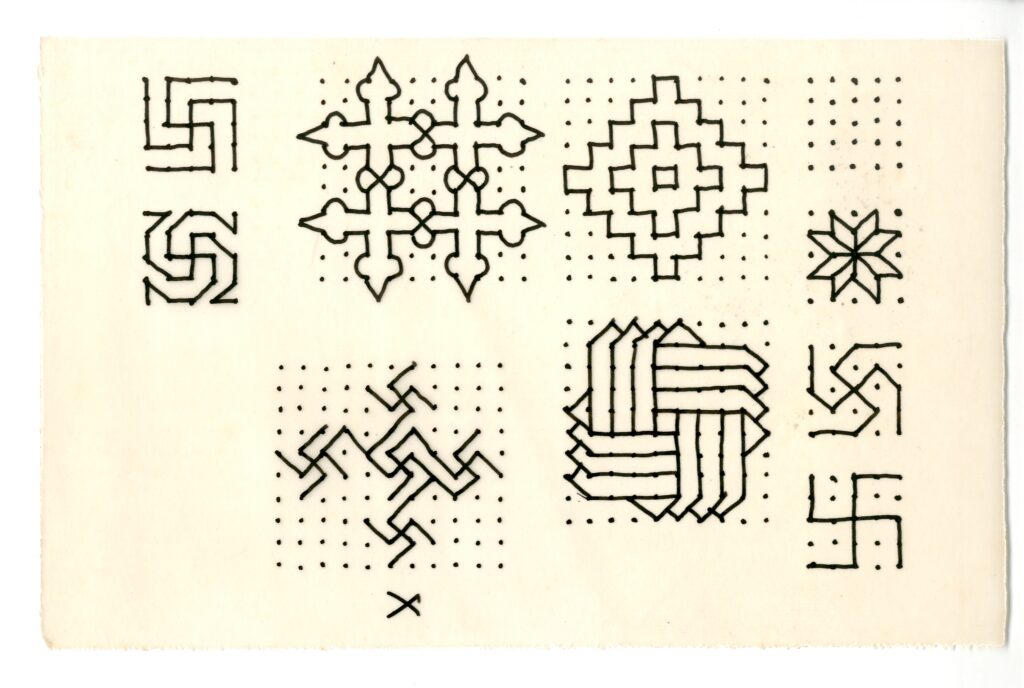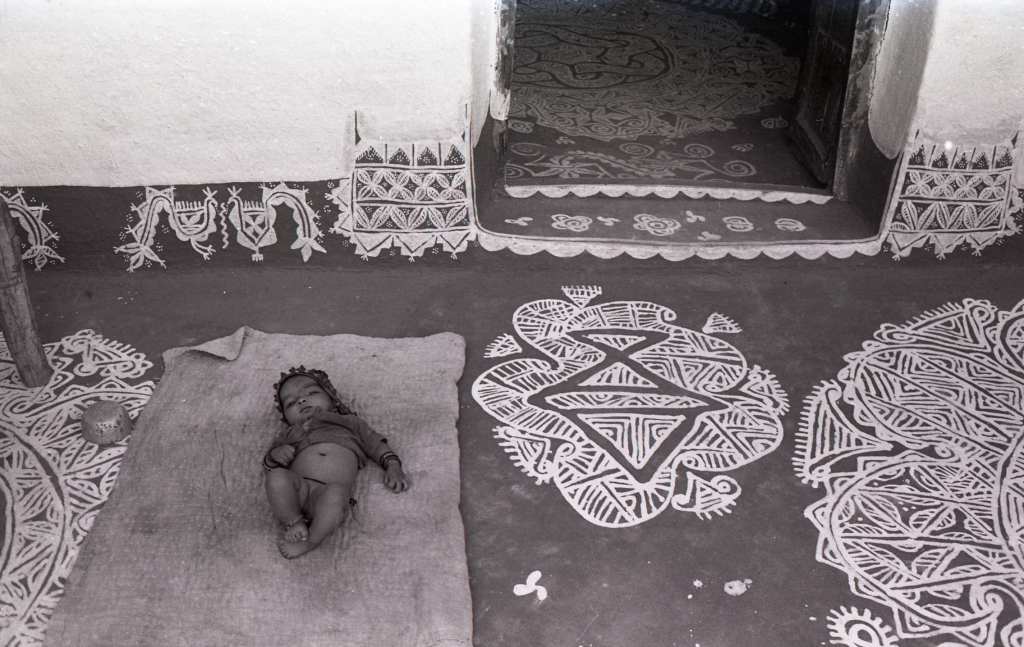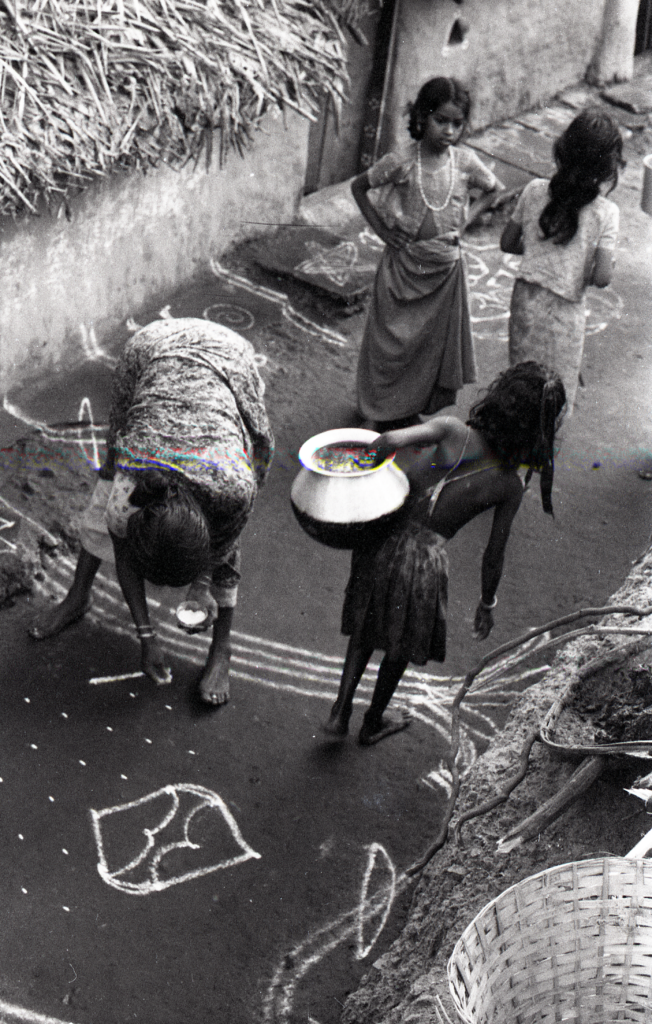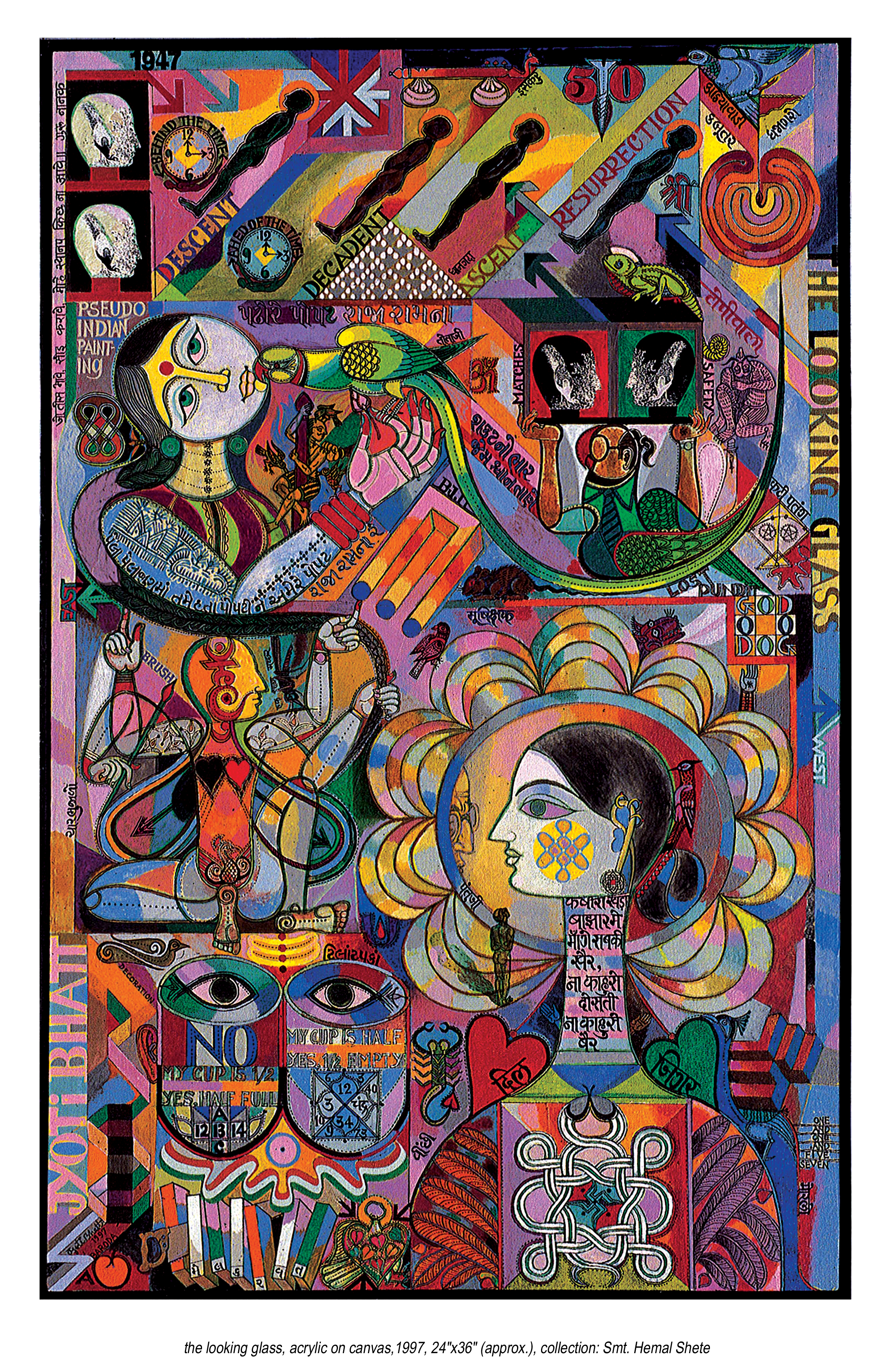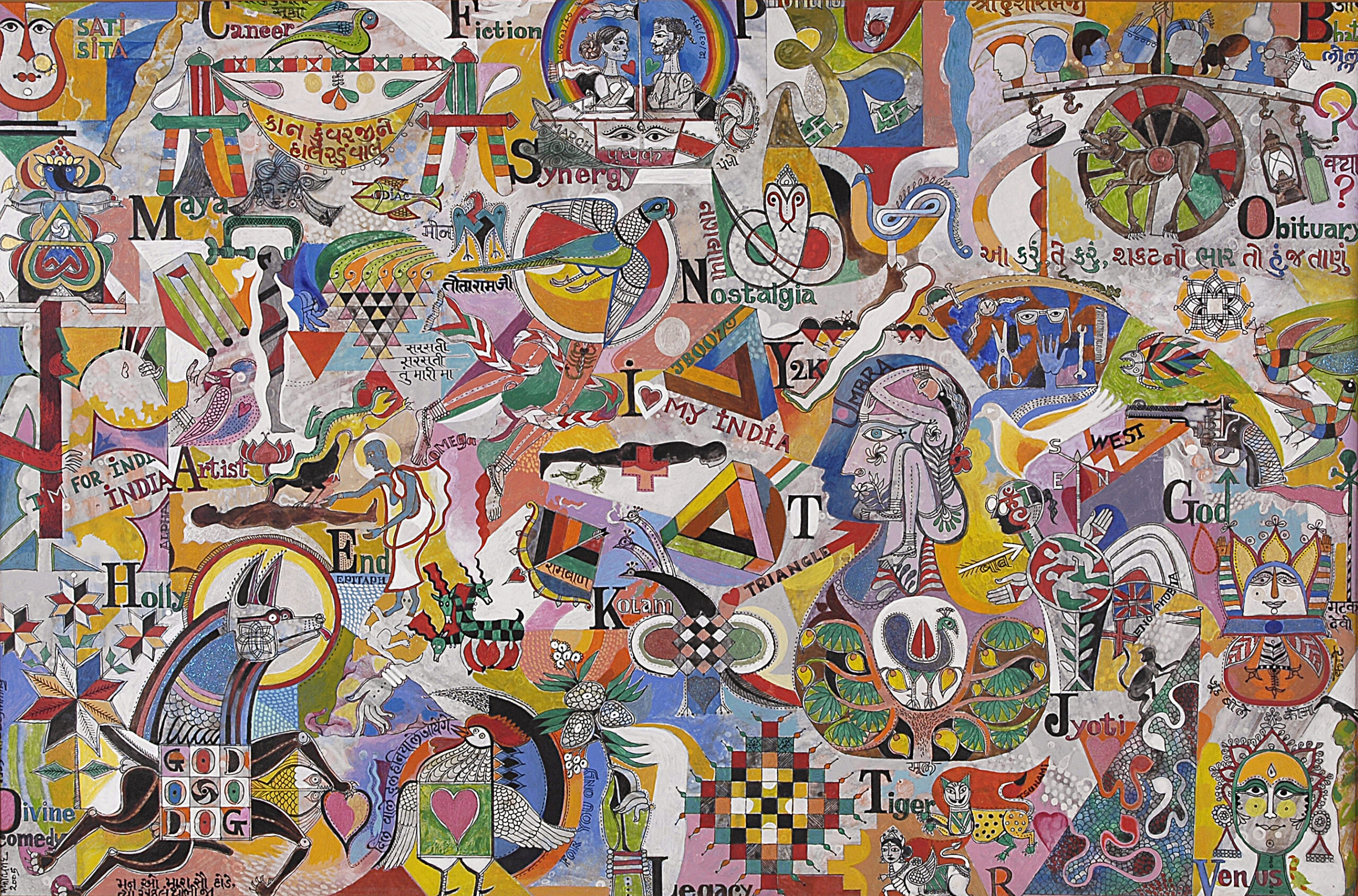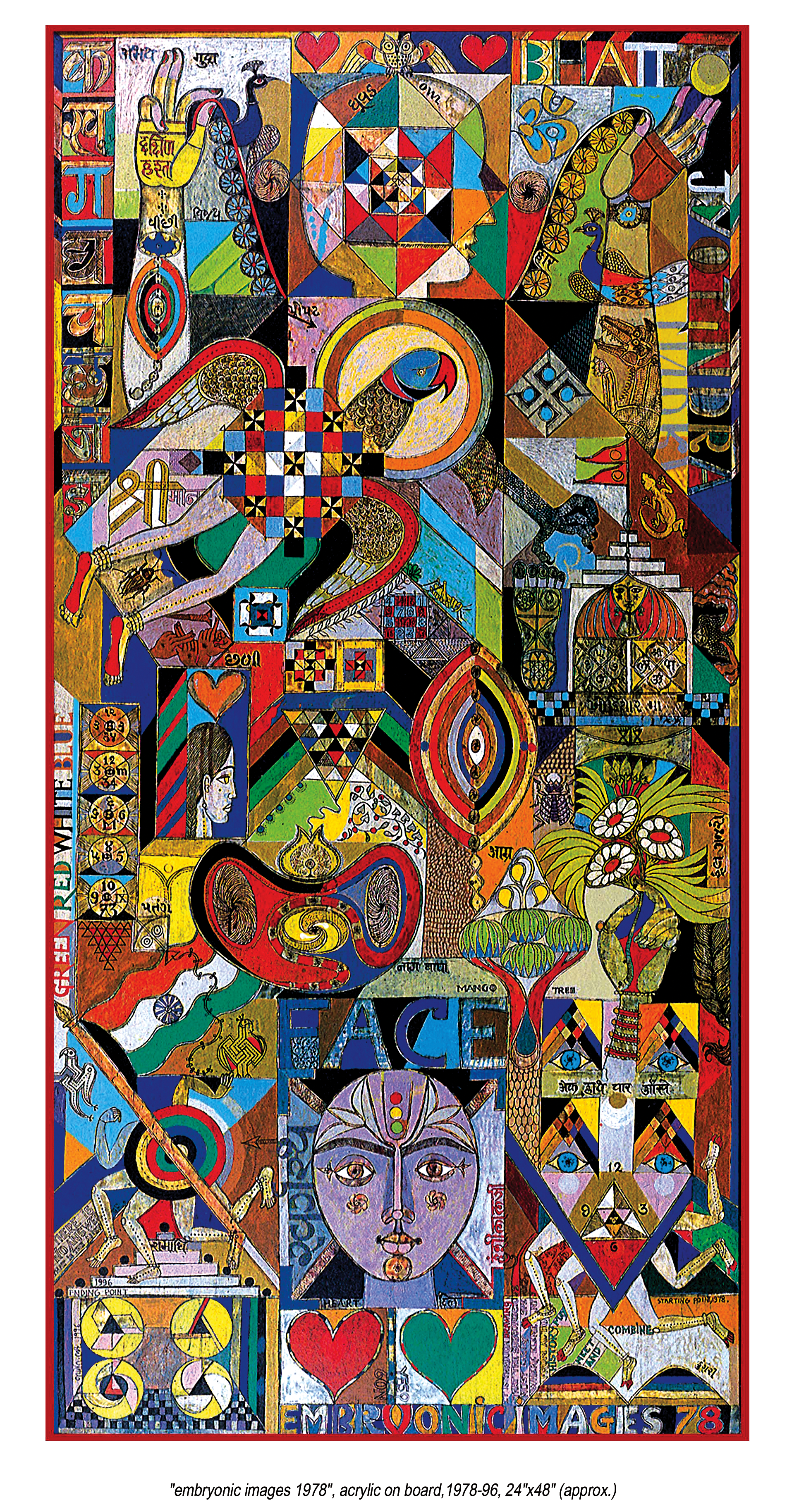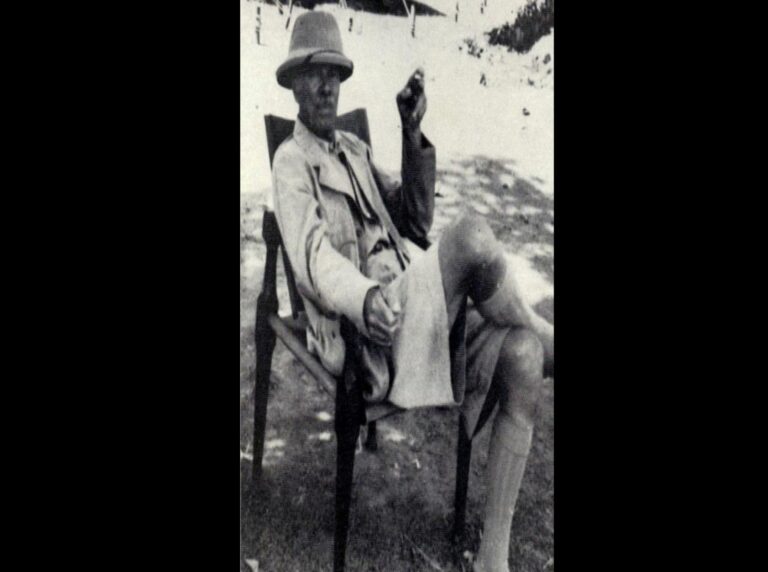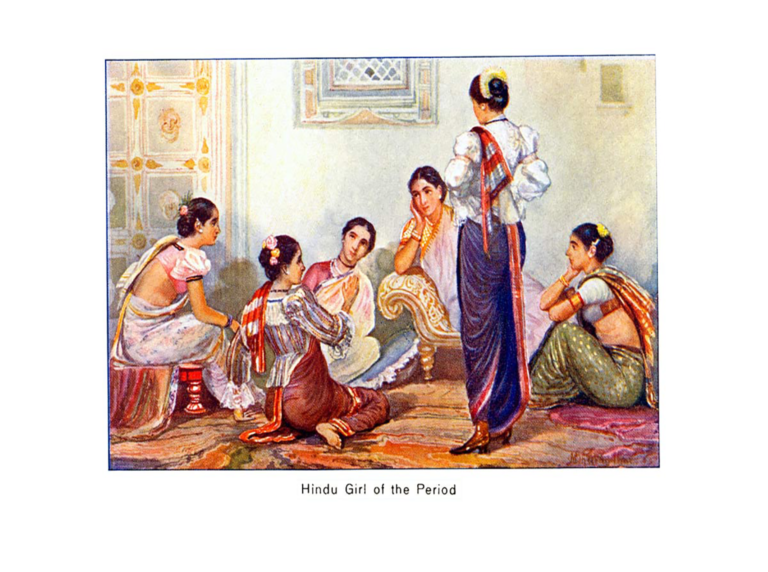Samira Bose
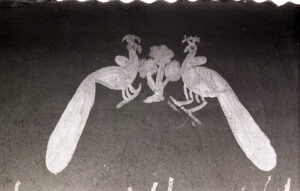
Image: Mandana Paintings, Kushtala, Rajasthan, 1975. Image Credit: Photograph by Jyoti Bhatt. Courtesy Jyoti Bhatt Archive, Asia Art Archive.
“Naturally, it is also a very popular motif among the women of Rajasthan villages, where even the momentary presence of a peacock in a court-yard or on a roof top is welcomed and considered auspicious. Perhaps to turn these fleeting moments into permanent ones, peacock motifs are often painted on walls.”
– Jyoti Bhatt

Image: Self-Portrait of Jyoti Bhatt, Baroda, 1967. Courtesy Jyoti Bhatt Archive, Asia Art Archive
Symbols and motifs resurface in varied forms across the materials in artist and educator Jyoti Bhatt’s personal archive, which is composed of photographs, notebooks, illustrations, designs, manuscripts, and documentation of his prints and paintings. The recurring forms reveal a process and a pursuit, a rapture, and a deep desire to make visible the presence of art in quotidian lived experience.
This selection of materials draws from the artist’s personal archive, which is digitally accessible on Asia Art Archive’s website. Jyoti Bhatt (b. 1934) was a student in one of the earliest batches at the Faculty of Fine Arts at M.S.U Baroda, where he later taught. Under the guidance of K.G. Subramanyan, Sankho Chaudhuri, and Kishore Parikh, Bhatt began traveling across India beginning in 1967 to ardently document what were called the ‘Living Traditions of India’ as a means to engage with and bring attention to the rich and varied artistic landscape of India. His archive contains around 50,000 images that he gathered over three decades.
The emphasis of this exhibition is on his documentation and engagement with what he called floor and wall graphics – art practices that play a decorative or ritualistic role in the domestic domain. The art forms had an impact on his visual sensibilities as a modern artist, and we can see the manner in which the intricate designs manifested in his works. As viewers scroll down this virtual display, they are encouraged to linger on the patterns, on their intricacies, and observe how they absorbed the artist.
Symbols, Motifs, Prints, and Patterns
Jyoti Bhatt’s fervent documentation was underscored by a desire to capture (and perhaps later even render) art forms that were facing threat under increasingly commercialised industrialisation. He was concerned that these art forms that composed daily life were not acknowledged nor credited in art historical discourse. During his travels he observed how women, in particular, from Madhubani in Bihar to Udupi in South India would draw simple diagrams with chalk, lime, or coloured powder as daily rituals at their thresholds, and on the walls of their homes, which would become much more complicated during festivals. Bhatt emphasised the diversity of how these were drawn, and while there were certain commonalities in the symbols – animals and birds, or designs that welcomed Hindu deities, there was immense diversity and and geometric innovation. These forms have multiple iterations – in southern states of India they are referred to as Kolam, as Muggulu in Andhra Pradesh, as Alpana in Bengal, and Mandana in Rajasthan, among many other variations. Bhatt’s photographs, in a sense, expose the formal qualities of these artistic practices, and the precise designs that compose them.
- Image: Govardhan Puja, Mandsaur, Madhya Pradesh, 1994 . Image Credit: Photograph by Jyoti Bhatt. Courtesy Jyoti Bhatt Archive, Asia Art Archive.
- Image: Maan Osha (Wall and Floor Painting), Banapur, Orissa (1987). Image Credit: Photograph by Jyoti Bhatt . Courtesy Jyoti Bhatt Archive, Asia Art Archive
- Image: Muggulu (Rangoli), Warangal, Andhra Pradesh, 1982-1983. Image Credit: Photograph by Jyoti Bhatt . Courtesy Jyoti Bhatt Archive, Asia Art Archive.
- Image: Chandarpur, Sarguja, Madhya Pradesh, 1983. Image Credit: Photograph by Jyoti Bhatt. Courtesy Jyoti Bhatt Archive, Asia Art Archive.
- Image: Mandana Paintings, Kushtala, Rajasthan, 1975 Image Credit: Photograph by Jyoti Bhatt Courtesy Jyoti Bhatt Archive, Asia Art Archive
Notes, Sketches, and Contemplations
The photographs in Bhatt’s archive are accompanied by extensive notes, sketches, and diagrams, and in these we can read how the modern artist dissects, measures, and investigates the forms. These notes serve what appears to be a contemplative purpose, accompanying the photographic documentation and yet serving as images in their own right.
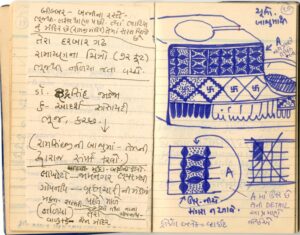
Image: Pages from Jyoti Bhatt’s diary, 1975-1981 Courtesy Jyoti Bhatt Archive, Asia Art Archive
- Image: Pages from Jyoti Bhatt’s diary, 1981-1983. Courtesy Jyoti Bhatt Archive, Asia Art Archive.
- Image: Pages from Jyoti Bhatt’s diary, 1981-1983. Courtesy Jyoti Bhatt Archive, Asia Art Archive.
- Image: Rangoli sketches by Jyoti Bhatt in pen and pencil, Date unknown. Courtesy Jyoti Bhatt Archive, Asia Art Archive.
- Image: Rangoli sketches by Jyoti Bhatt in pen and pencil, Date unknown. Courtesy Jyoti Bhatt Archive, Asia Art Archive.
Living With(In) and On Art
In his musings on photography, Bhatt wonders about how much of the background should be brought into the frame of his documentation, as also about the medium of the camera itself. There is much to be uncovered and debated about the artist’s gaze and lens, and yet through his archive we come across albums where images are clicked in quick succession, and individuals and families seem to be going about their daily life – they either posing willingly or appear fairly comfortable in his presence. In capturing these traditions, Bhatt also brings forth the thriving lives of communities that create the art forms, and the labour and collaborative authorship that goes into the practices, raising several questions about his role as an individual modern artist on a pursuit that was not motivated by state or institutional agendas.
- Image: Mandana Paintings, Kushtala, Rajasthan, 1980. Image Credit: Photograph by Jyoti Bhatt. Courtesy Jyoti Bhatt Archive, Asia Art Archive.
- Image: Mandana Paintings, Kushtala, Rajasthan, 1980. Image Credit: Photograph by Jyoti Bhatt. Courtesy Jyoti Bhatt Archive, Asia Art Archive.

Image: Muggulu (Rangoli), Udupi, 1982-1997. Image Credit: Photograph by Jyoti Bhatt. Courtesy Jyoti Bhatt Archive, Asia Art Archive.
- Image: Muggulu (Rangoli), Warangal, Andhra Pradesh, 1982-1983. Image Credit: Photograph by Jyoti Bhatt. Courtesy Jyoti Bhatt Archive, Asia Art Archive.
- Image: Kolam (Floor Graphic), Rangoli, Madras, 1974. Image Credit: Photograph by Jyoti Bhatt. Courtesy Jyoti Bhatt Archive, Asia Art Archive.
The selection of the artist’s work presented below are not for viewers not to prise apart, but to engage with in their intricate density. Perhaps it is the concentration of the assemblages that conveys the manner in which the artist encountered and remained with images, prints, and patterns that possessed him – forms that we encounter in our daily lives or travels, but do not necessarily regard or remember. The materials in Jyoti Bhatt’s archive makes us regard these once again, anew.
The artist’s rigourous investment in documentation through vast and varied landscapes, the desire to highlight artistic life and craftsmanship in “Indian” life, and their presence in his oeuvre reveal perhaps an impulse to “turn those fleeting moments into permanent ones.”
- Image: Images Getting Lost in Oblivion, Jyoti Bhatt, 1994, Mixed intaglio on paper, 25.4cm x 31.7cm. Courtesy Jyoti Bhatt Archive, Asia Art Archive.
- Image: The Looking Glass, Jyoti Bhatt, 1997, Acrylic on canvas, 91.4cm x 60.9cm. Courtesy Jyoti Bhatt Archive, Asia Art Archive.
- Image: A-B-Zee of My India, Jyoti Bhatt, 2005, Acrylic, pen and ink on board, 60.9cm x 91.4cm. Courtesy Jyoti Bhatt Archive, Asia Art Archive.
- Image: Embryonic Images 1978, Jyoti Bhatt, 1978, Acrylic on board, 121.9cm x 60.9cm. Courtesy Jyoti Bhatt Archive, Asia Art Archive.
References and Resources:
- Jyoti Bhatt’s quote on peacock motifs is from ‘Mandana: Wall and Floor Decorations’, Volume 12, No. 7 of the journal The India Magazine of Her People and Culture, June 1992.
- Access the Jyoti Bhatt Archive on Asia Art Archive’s website.
- Access Jyoti Bhatt’s manuscripts on floor and wall graphics within the archive here.
- Access the ‘Walls and Floors: The Living Traditions of Village India – Photographs by Jyoti Bhatt’ exhibition here. The exhibition catalogue contains photographs by Jyoti Bhatt depicting the living traditions of village India, emphasizing on the necessity to document living cultures. The catalogue has been published with the help of Bharat Bhavan and Indira Gandhi Rashtriya Manav Sangrahalaya, Bhopal; Transpek Industries Ltd. and Light Publications Ltd., Baroda; and C.P.A., Bombay. Courtesy Jyoti Bhatt Archive, Asia Art Archive.
This selection of materials has been put together by Samira Bose (Programmes Coordinator at Asia Art Archive in India) with assistance from her colleagues.

